The decline of the token does not devalue the product that the developers are building. To be precise, it is low circulation/high fully diluted valuation (Fully Diluted Valuation, FDV).
background
Since the beginning of the year, every ordinary resident of the crypto world has realized the importance of this year, as the growth season especially incentivizes those exchanges that are preparing for 3-4 listings per week. In fact, everything was going well until the market began to correct.
I divide the stages of greed and disappointment into two time periods:
- greedy. November 2023 - March 2024.
- disappointment. March 2024 – July 2024 (we are in this phase now, same sentiment).
greedy

Greedy periods are characterized by a sustained flow of capital from one category to another, with almost all assets rising. Here are some examples of pump and dumps:
Overall positivity is underpinned by $BTC which gained an ETF in January and surged from 40k to 70k in a matter of months. Altcoin are also booming, with newly issued tokens being actively supported by speculators and investors who are snapping up every token.
During this period, the market lacks liquidity. Funding is so low that while one ecosystem grows, another is lifeless, and once the first is pushed to its limits, liquidity is redirected to the next, and the cycle continues.
ETH → Sol → Avax or Sui
In terms of categories, there aren’t many choices:
L2 → AI → BTC-fi (and BRC-20) → Game-fi → Meme
While we can't say this is cyclical, we can certainly say that every category showed growth during these six months.
Didn't see any negative tweets related to FDV, such as $TIA. It listed on Binance with a market capitalization of $200 million, compared to FDV's $2 billion.
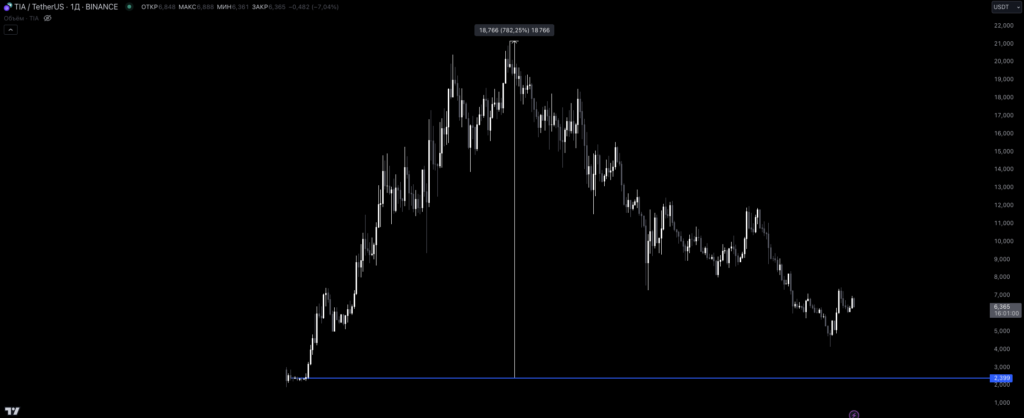
$TIA l 1D l Price Performance
Market makers take advantage of this and it is not difficult to sell charts like this to the community. So, let's summarize:
— Greed
— low liquidity
— Performance of the main categories (the well-known ones)
disappointment
The period of disappointment gradually began with the surge of $PEPE in February this year. At the time, the market was experiencing its second meme season, which was even more intense than the previous one.
While the Binance listing is still relatively good, the growth range for new coins has dropped from 200%-300% to 50%-100%. The idea of buying new “cheap” coins is still viable, but interest in them is slowly starting to wane.
The first sign of an overheated market was the launch of L2 solution Starknet ($STRK), which raised significant doubts about the prospects of a token ranked in the top 15 cryptocurrencies by FDV. This raises a simple question: "Where can it go from here?"
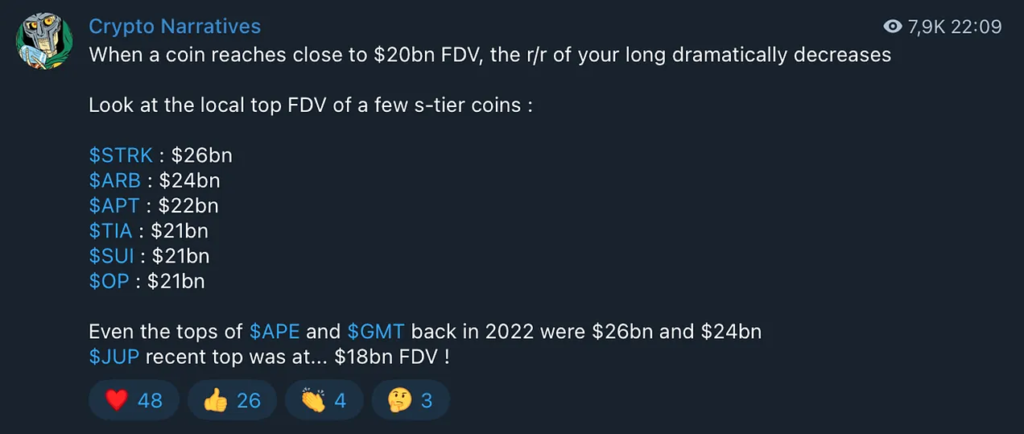
Source: Viktor's channel
While the market was in disarray, $BTC decided to test the strength of a new wave of Altcoin, and the results were... disastrous. Bitcoin is down about 15%, while tech tokens have plunged 30%-40%.

The first signs of weakness in the Altcoin market forced users to look for alternatives, and they found them in memes. In my opinion, the resurgence of the meme season started from the moment on March 11, 2024, when the indicators on pump.fun started to grow exponentially. The result of this growth is the successful launch of new categories of memes, such as:
WIF, BOME, MEW, MICHI, BRETT, BONK (in no particular order).

Source: Dune
Crypto Traders (CT) clearly saw the accumulation of capital in the meme and its strong hold during the decline of Bitcoin and Ethereum. This leads to the conclusion: "Where there is attention and money, there is the greatest benefit."
Additionally, speculators' impressive results provide additional support to the meme. By weighing each factor and observing the strong rise in memes during the first half of the year, we can now see that every major event in the world is being meme-ified on the Solana blockchain.
When it comes to tokens funded by venture funds, the situation is dire. Crypto traders come to this conclusion for several reasons:
- Worrying market cap/FDV ratio.
- Bad token economics (small cliff, high release).
- High profits for venture investors (assuming a startup raises $50 million in FDV financing but enters the market with $1 billion, that is 20 times the net profit for an average project on a secondary exchange).
- Market pressure from airdrop candidates (sell the tokens immediately upon receipt).
What did we end up with?
A heavily diluted token in value, huge multiples on the fund, very few tokens in circulation (subsequent unlocks will destroy the price), and huge FDV.
This situation is made worse by the sheer volume of these coins. Each project sells itself as the best solution to the N problems of cryptocurrency. This worked last fall for the following reasons:
- Liquidity is not diluted by memes.
- Projects are not queuing up to start, but waiting for better conditions.
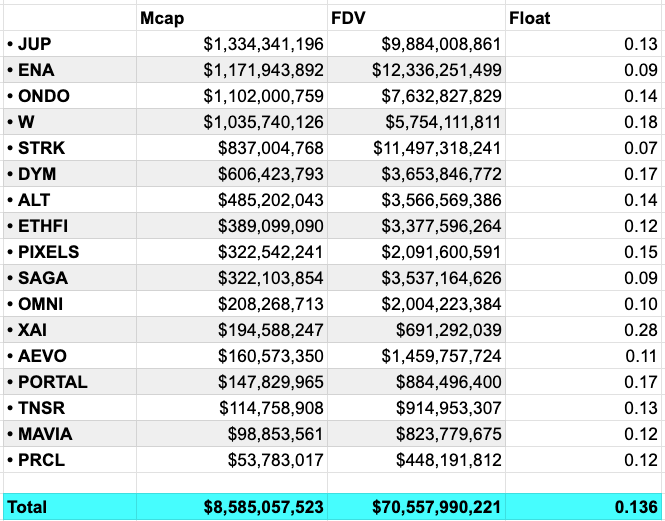
Chart source: Crypto, Distilled

Image source: flow
Disdain for "VC tokens" peaked with the rise of Worldcoin ($WLD), a market maker that has been building since its listing. Worldcoin is a project led by Sam Altman himself, who owns OpenAI (the company from which ChatGPT comes). Crypto traders are using $WLD as a proxy for betting on OpenAI’s growth, trying to take advantage of each new update in their trading strategies.
"ChatGPT has a new update? $WLD takes off."

Examples of Fear, Uncertainty and Doubt (FUD) about Worldcoin, source: DeFi^2
Only 1.14% of the tokens are on the market, which creates ideal conditions for market makers to manipulate.
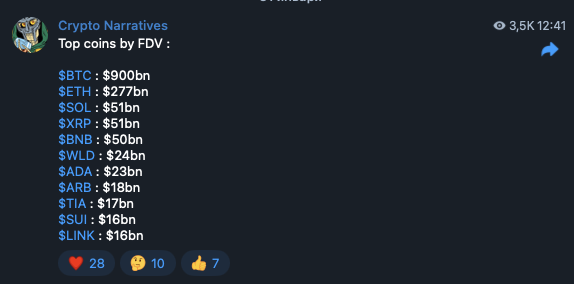
Source: Viktor’s TG channel
The chart shows that $WLD currently ranks among the top ten crypto assets.
The argument for VC tokens was solidified in April, when the Altcoin market began to experience the second phase of a violent sell-off, the same month developers/VCs came into direct conflict with the forces behind the meme.
While I can't say for sure who won, the influx of users into pump.fun suggests that traders and speculators prefer memes to bland infrastructure. Additionally, the price dynamics of the latest coin to be listed are dismal, with almost no one willing to buy anything.
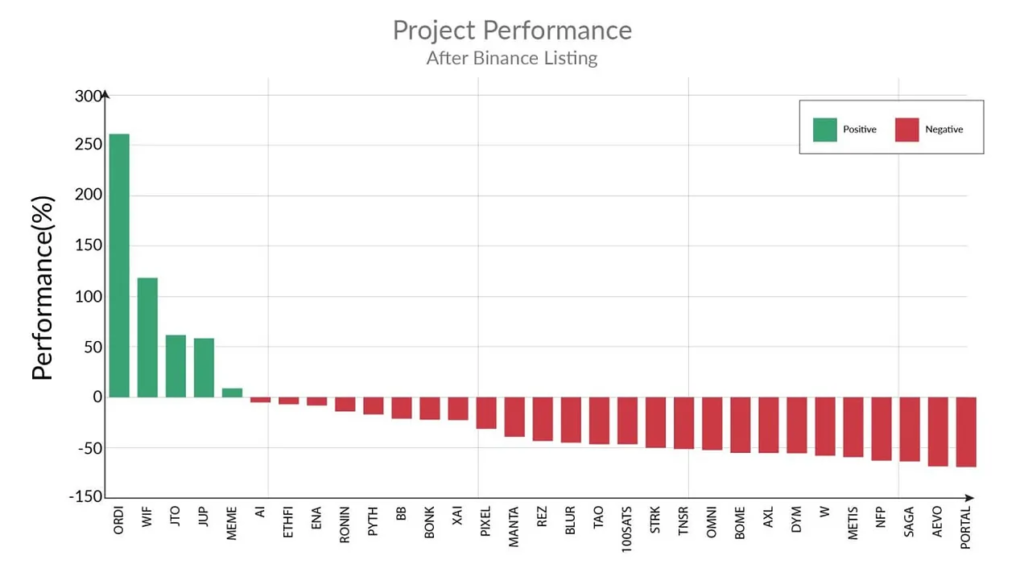
Source: Crypto Nova
Summarize
Crypto Trader (CT) Behavior in Greedy Phase:
a. FDV does not matter; the hype of the project and the number of tokens at launch are important (the less, the easier it is to hype)
b. A new token that fits the current narrative (btc-fi, ai, game-fi, social-fi…) is attractive regardless of its token economics (think Shrapnel)
c. Prefer risk taking over balanced analysis
Crypto Trader (CT) Behavior in the Disappointment Phase:
a. Listed tokens are not profitable; looking for alternatives, found in meme, since all listed tokens are traded, 100% belong to the community significant cough.
b. Look for catalysts that benefit the meme sector (FDV/low flow).
c. Disappointment with infrastructure tokens is not due to their technical complexity, but to lack of liquidity. It's hard to sell something to the community that's down.
This provides a rough context for the past 7-8 months. My main question is: "How strong is the argument that new coins will not recover and show their performance?"
What happened last cycle?
In order to make a strong analysis, I think we need to look back at history and assess the overall context of Altcoin development. The more information I collect, the richer the article becomes.
Listed
I often hear this statement: "Binance has a lot of projects listed now, which significantly dilutes liquidity, which did not exist before."
Initially I thought this argument made sense and required no further analysis.
However, I decided to independently analyze the number of coins Binance has launched on the market, and the results surprised me.
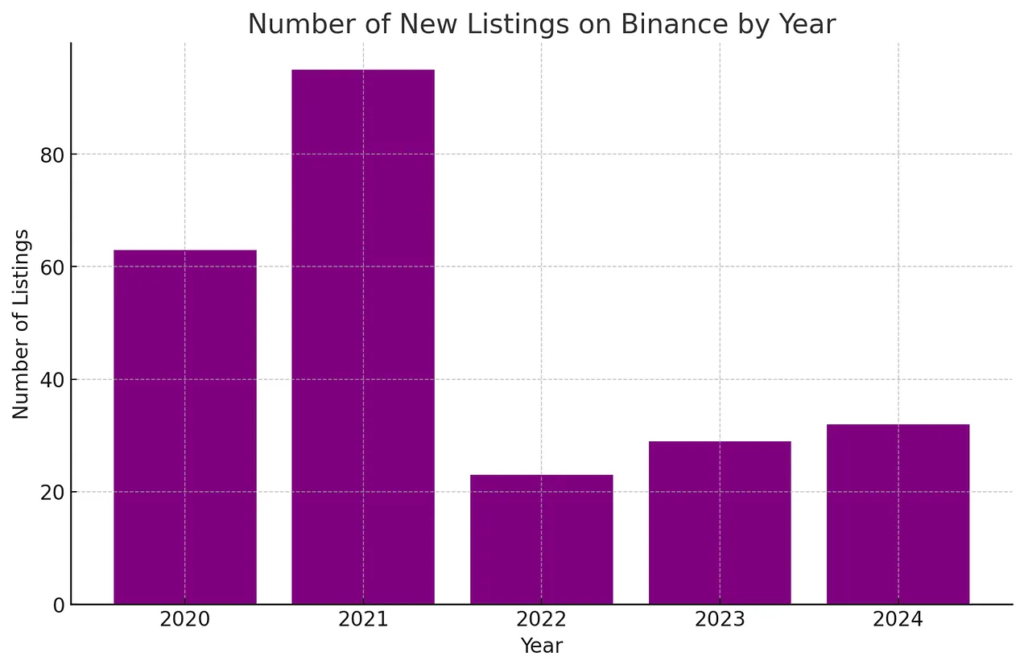
Produced by ChatGPT
Preliminary calculations allow for a possible deviation of 2-3 points in either direction, which is acceptable accuracy.
After some thought, I concluded that the above argument stems from the author remembering 5-10 projects that survived the bear market and performed well.
However, in reality many projects are launched, hyped and then withered. Due to the short life cycle of tokens, their memory fades over time, which is called "survivor bias", while projects that achieve product market fit (PMF) and maintain demand are remembered .
Give it a try, which coins do you remember from 2020-2021? For me, SOL, AVAX, FTM, UNI, LDO come to mind. However, there are actually ten times more coins; they either fail to reach PMF or are shrinking rapidly.
Based on this information, we cannot say that the last cycle consisted of N successful projects.
Here are some examples of tokens from the last cycle:
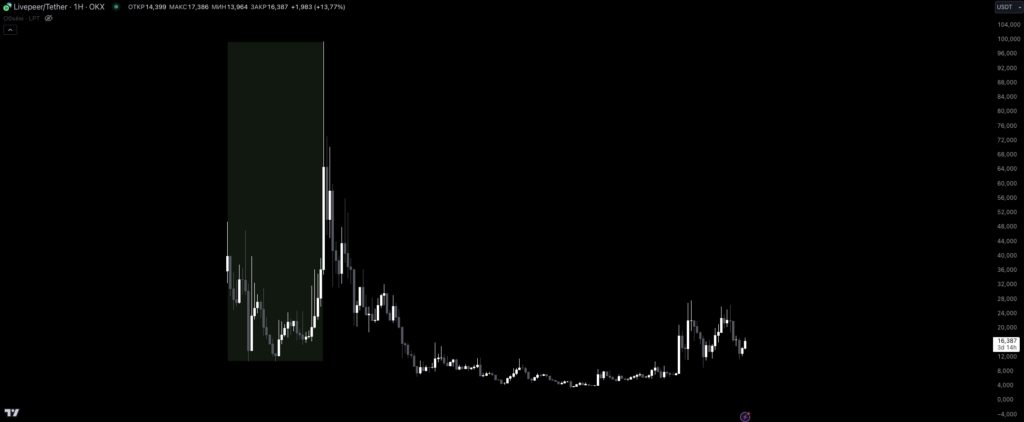

More examples are: $ALICE, $SKL, $ROSE, $AKRO, $AUDIO, $ORN, $ILV, $MASK.
You can view the graphs for these projects yourself.
I have a question for you: have you heard of these projects? Currently using any of these?
Bear markets tend to weed out tokens with weak products or poor token economics, but every token has a chance to prove itself during a bull market. Some of these projects are infrastructure and some are applications.
You may ask, what about the number of tokens on the market?

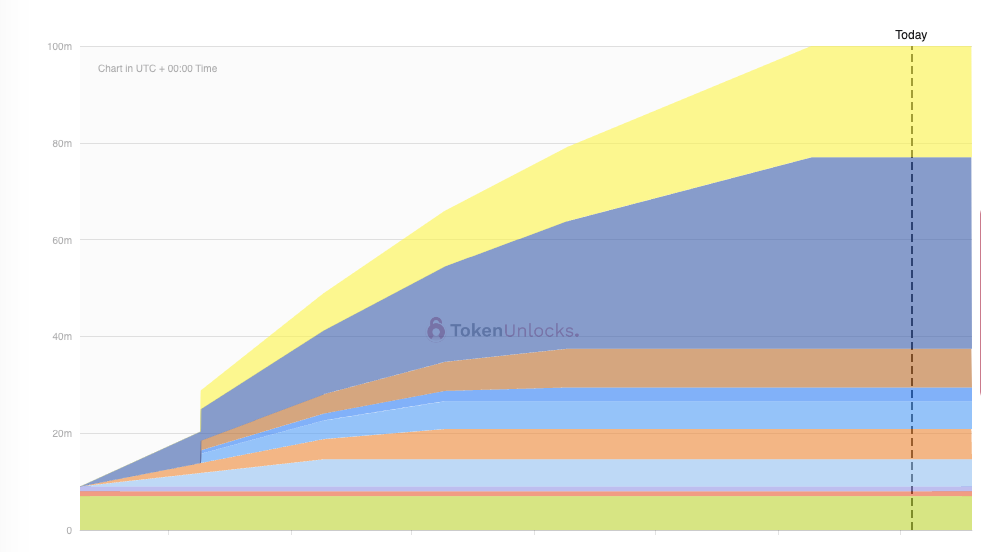
These projects were actively supported by venture capital investors, and it was obvious at the time of their launch that they had low liquidity/high FDV. However, this has not stopped them from showing multiple growth as investors and teams unlock tokens starting from TGE (Token Generation Event).
in conclusion
- Low liquidity/high FDV is part of the life cycle of any altcoin as it searches for Product Market Fit ( PMF ) . The better thing about the current market is that most investors have a one-year cliff period, followed by a two-year unlock period.
- Survivorship bias of projects compared to those that failed to achieve PMF is not a valid argument.
- Comparing the listing of Binance, one can draw a simple conclusion: Binance became more cautious about projects (although not much from March to July) and listed Tier 1 (2) projects, and of course those incubated by themselves project.
Where are we now and what happens next?
First of all, I would like to point out that in the cycle of new coins, we are not even 1% off track. Here are some comparisons:
- $UNI, -50% and -79%. See the Trading view chart for details.
- $SOL, -68% and -79%. See the Trading view chart for details.
- $NEAR, -59%. See the Trading view chart for details.
- Price performance since the TGE event.
Based on these charts, if the coin drops ~50%, would it be a bad idea to buy $UNI? Or buy $SOL which is down about 70%?
Argument: A token’s decline does not devalue the product developers are building.
In my opinion, tokens are a necessary means of attracting attention. Product growth in the crypto space occurs through several pathways:
- The price of the token increases. The community began to question whether the token’s growth was related to the uniqueness of the product. What narrative drives the token?
- Possible backtracking reward action.
- Recommendation = promotion of product by influencer (important). Again, there has to be a monetization element.
In a weak market environment, whether it is a weak project or a strong project, short-term declines are normal.
About your current project?
I want to point out that I could be wrong and that's normal. There will always be some projects that are launched for the purpose of cashing out ($SAGA, for example, does not have a single line of blockchain code). Therefore, before determining the future price trend of a new coin, I would like to add some filters:
- Simple, clear and common (application user) product.
- Extensive user base, application does not rely on tokens.
- Strong team, ecosystem, investors.
- Alignment of tokens with narrative.
I am not saying that every token released in 2023-2024 will perform strongly. While this is possible with high market liquidity, I don't like diversifying my funds on boring and complex protocols (made the mistake of overestimating projects like $NGL, $MASA, and other crap in the past).
Let’s assume a list of coins and briefly analyze them:
ZRO (LayerZero) — Infrastructure for transferring funds between one blockchain and another. Cheap, fast and efficient. Brian earned >50 million, no tokens, in the two years the protocol was operating.
$ZK (zkSync) — A L2 solution designed to expand the Ethereum ecosystem. zk technology ensures safe and fast transactions. Please refer to the detailed information about zk, as well as Vitalik's thoughts. Top teams and ecosystems where you can evaluate metrics.
$OP (Optimism) — Same as L2, but using different transaction processing methods (optimistic rollups). Based on OpStack, the Coinbase team launched their own L2 blockchain - Base, which is currently ranked in the top three of all launched rollups.
One might argue that these tokens are useless, they have no utility, no one needs them, etc. The 2020-2021 cycle shows that none of this matters until greed gives way to disappointment. On the flip side, I would say we are not even close to greed yet, and what happens in the fall – spring of 2023-2024 is just the beginning, in my humble opinion.
Let this tweet support my point.
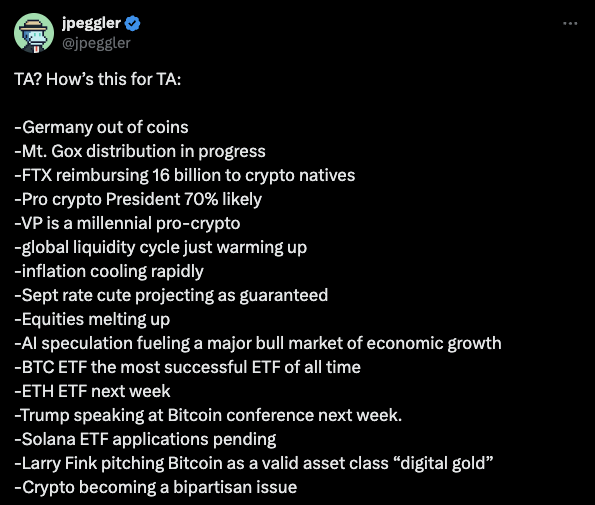
Here are some considerations for TA (technical analysis):
- Selling Bitcoin in Germany
- Mt. Gox compensation in progress
- FTX repays $16 billion to crypto users
- A pro-crypto president has a 70% chance of being elected
- Vice President Is Pro-Crypto Millennial The Global Liquidity Cycle Is Just Beginning
- Inflation cools rapidly
- September rate cut almost certain
- Stock market continues to rise
- AI speculation drives economic bull market
- BTC ETF Becomes Most Successful ETF Ever
- ETH ETF launching next week
- Trump to speak at Bitcoin conference next week
- Solana ETF application pending
- Larry Fink promotes Bitcoin as "digital gold"
- Cryptocurrency becomes bipartisan issue
Source: jpeggler
I have no idea how much my or your portfolio will grow, the purpose of this article is to provide a comparative analysis of Altcoin this cycle and past cycles. In addition, analyze the trends of meme coins.
To me, it doesn't matter who is right, it matters who makes money and who doesn't.







